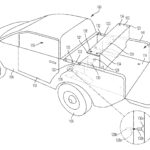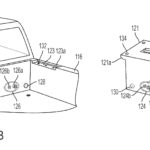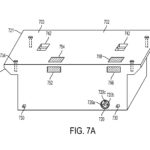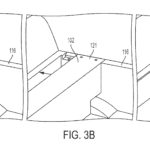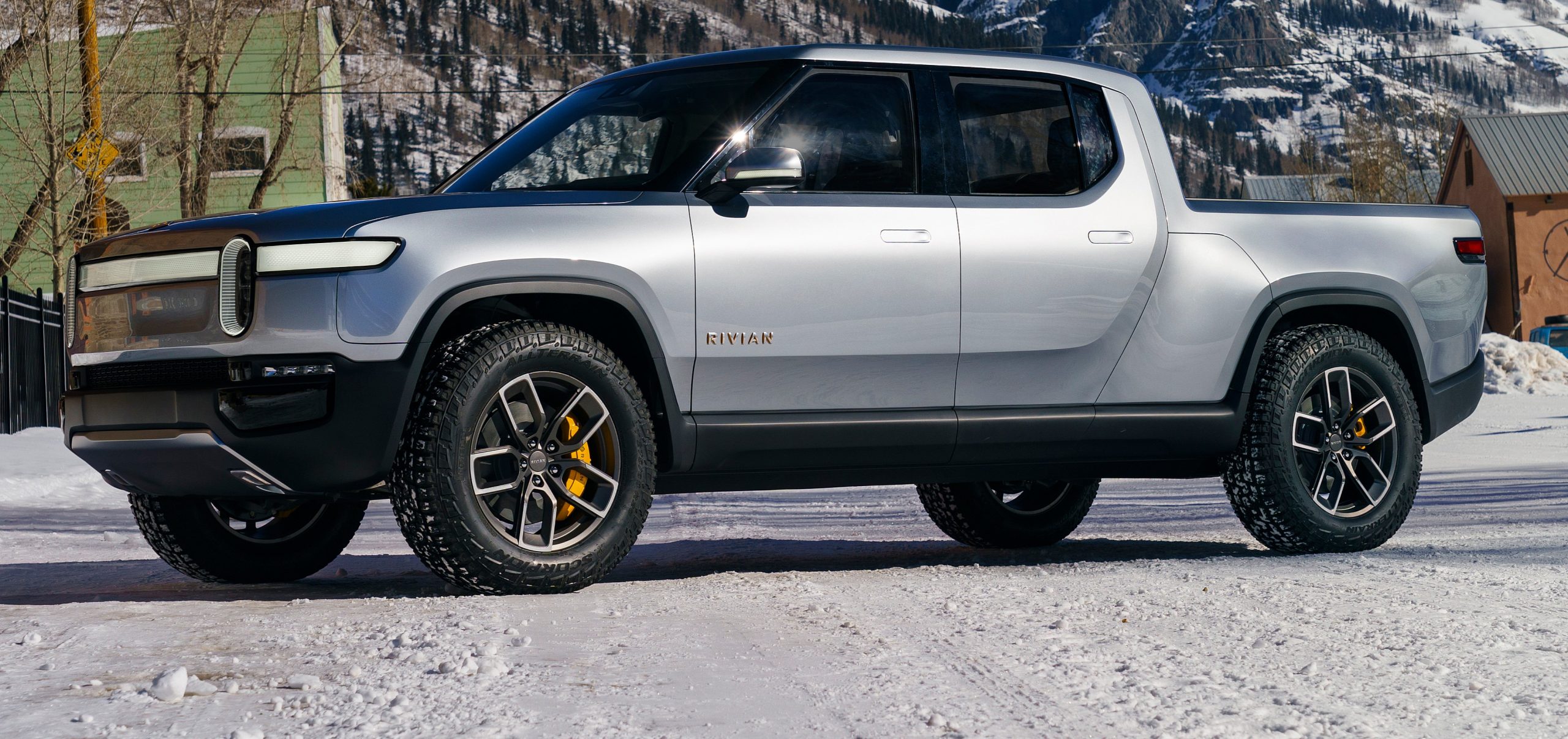

News
Rivian patent reveals R1T auxiliary battery that pushes range beyond 400 miles
Rivian CEO RJ Scaringe previously mentioned that his electric truck company is developing an auxiliary battery that acts as a “digital jerry can” for its vehicles, allowing them to travel beyond their listed range. Thanks to a recently published patent application, more details on this auxiliary battery system are now available.
The patent, titled “Electric Vehicle With Modular Removable Auxiliary Battery With Integrated Cooling,” describes an external battery module that can be fitted to an electric vehicle, thereby providing it with additional range. This is especially important for Rivian’s trucks, since they are designed to go off-road. Thus, the company notes that there is a need for an “auxiliary battery system for an electric automotive vehicle to increase the range of the electric vehicle, and in particular, an auxiliary battery system that can be carried by the electric vehicle.”
As could be seen in the patent application, the auxiliary battery system would be installed on the cargo area of a truck. In the case of the R1T pickup, for example, the battery module would be fitted on the truck’s bed. The entire module also includes latching mechanisms and connectors, which are designed for easy installation and removal.
- Illustrations depicting Rivian’s auxiliary battery system. (Photo: Rivian Automotive)
- Illustrations depicting Rivian’s auxiliary battery system. (Photo: Rivian Automotive)
- Illustrations depicting Rivian’s auxiliary battery system. (Photo: Rivian Automotive)
- Illustrations depicting Rivian’s auxiliary battery system. (Photo: Rivian Automotive)
Illustrations depicting Rivian’s auxiliary battery system. (Photo: Rivian Automotive)
Perhaps more impressively, Rivian’s design for its auxiliary battery utilizes the cooling systems of the vehicle itself. Upon installation of the battery unit, Rivian notes that the vehicle’s systems would perform necessary adjustments, ensuring that ride quality and driveability do not get compromised or unnecessarily changed. Rivian outlines this process in the following section:
“When outfitted with the auxiliary battery, the electric vehicle can detect the fact that the auxiliary battery is attached to (e.g., mounted in) the electric vehicle (e.g., in cargo bed) and automatically set one of multiple predetermined feature sets, e.g., that pertain to driving performance of the electric vehicle. Such feature sets may set, for example, certain suspension characteristics appropriate for the attachment of the auxiliary battery, such as, e.g., a setting for firmness of ride of the vehicle, braking performance/sensitivity, nominal suspension height, effective steering ratio, etc.”
It should be noted that the auxiliary battery module design outlined in Rivian’s recently-published patent appears to be optimized for the R1T pickup truck. Based on the illustrations provided by the company, the external battery seems to take up a substantial amount of space in the all-electric pickup’s bed. With this in mind, it remains to be seen how the company would design a similar battery solution for the R1S SUV, which does not have a bed like the R1T. Nevertheless, considering Rivian’s polished approach to its designs, it is quite exciting to see how the company would equip a seven-seater SUV with a range-extending battery module.

RJ Scaringe noted in a previous interview that one of the reasons behind Rivian’s extra large battery packs (offered at 105 kWh, 135 kWh, and 180 kWh configurations) is to ensure that drivers would have enough range for their adventure needs. This certainly appears to be the theme with Rivian’s vehicles, as could be seen in its top-tier variants’ range of 400 miles per charge. Coupled with an auxiliary battery system, the company’s trucks could very well close in or even exceed the 500-miles per charge mark.
Similar to other new automakers such as Tesla, Rivian’s first vehicles are made for the luxury niche, not the mass market. As noted by RJ Scaringe in an interview with Green Tech Media, Rivian’s target demographic are the people who are “spending $70,000 or $80,000 on a GMC Denali or a Chevy Suburban or a Land Rover Discovery or a fully loaded Ford F150.” For these potential customers, the company can tolerate no compromises, and in Scaringe’s words, “under-promise and over-deliver.” This is especially true with regards to the R1T and the R1S’ range.
Rivian’s patent application for its auxiliary battery system could be accessed here.

News
Tesla starts showing how FSD will change lives in Europe
Local officials tested the system on narrow country roads and were impressed by FSD’s smooth, human-like driving, with some calling the service a game-changer for everyday life in areas that are far from urban centers.

Tesla has launched Europe’s first public shuttle service using Full Self-Driving (Supervised) in the rural Eifelkreis Bitburg-Prüm region of Germany, demonstrating how the technology can restore independence and mobility for people who struggle with limited transport options.
Local officials tested the system on narrow country roads and were impressed by FSD’s smooth, human-like driving, with some calling the service a game-changer for everyday life in areas that are far from urban centers.
Officials see real impact on rural residents
Arzfeld Mayor Johannes Kuhl and District Administrator Andreas Kruppert personally tested the Tesla shuttle service. This allowed them to see just how well FSD navigated winding lanes and rural roads confidently. Kruppert said, “Autonomous driving sounds like science fiction to many, but we simply see here that it works totally well in rural regions too.” Kuhl, for his part, also noted that FSD “feels like a very experienced driver.”
The pilot complements the area’s “Citizen Bus” program, which provides on-demand rides for elderly residents who can no longer drive themselves. Tesla Europe shared a video of a demonstration of the service, highlighting how FSD gives people their freedom back, even in places where public transport is not as prevalent.
What the Ministry for Economic Affairs and Transport says
Rhineland-Palatinate’s Minister Daniela Schmitt supported the project, praising the collaboration that made this “first of its kind in Europe” possible. As per the ministry, the rural rollout for the service shows FSD’s potential beyond major cities, and it delivers tangible benefits like grocery runs, doctor visits, and social connections for isolated residents.
“Reliable and flexible mobility is especially vital in rural areas. With the launch of a shuttle service using self-driving vehicles (FSD supervised) by Tesla in the Eifelkreis Bitburg-Prüm, an innovative pilot project is now getting underway that complements local community bus services. It is the first project of its kind in Europe.
“The result is a real gain for rural mobility: greater accessibility, more flexibility and tangible benefits for everyday life. A strong signal for innovation, cooperation and future-oriented mobility beyond urban centers,” the ministry wrote in a LinkedIn post.
News
Tesla China quietly posts Robotaxi-related job listing
Tesla China is currently seeking a Low Voltage Electrical Engineer to work on circuit board design for the company’s autonomous vehicles.

Tesla has posted a new job listing in Shanghai explicitly tied to its Robotaxi program, fueling speculation that the company is preparing to launch its dedicated autonomous ride-hailing service in China.
As noted in the listing, Tesla China is currently seeking a Low Voltage Electrical Engineer to work on circuit board design for the company’s autonomous vehicles.
Robotaxi-specific role
The listing, which was shared on social media platform X by industry watcher @tslaming, suggested that Tesla China is looking to fill the role urgently. The job listing itself specifically mentions that the person hired for the role will be working on the Low Voltage Hardware team, which would design the circuit boards that would serve as the nervous system of the Robotaxi.
Key tasks for the role, as indicated in the job listing, include collaboration with PCB layout, firmware, mechanical, program management, and validation teams, among other responsibilities. The role is based in Shanghai.
China Robotaxi launch
China represents a massive potential market for robotaxis, with its dense urban centers and supportive policies in select cities. Tesla has limited permission to roll out FSD in the country, though despite this, its vehicles have been hailed as among the best in the market when it comes to autonomous features. So far, at least, it appears that China supports Tesla’s FSD and Robotaxi rollout.
This was hinted at in November, when Tesla brought the Cybercab to the 8th China International Import Expo (CIIE) in Shanghai, marking the first time that the autonomous two-seater was brought to the Asia-Pacific region. The vehicle, despite not having a release date in China, received a significant amount of interest among the event’s attendees.
Elon Musk
Elon Musk and Tesla AI Director share insights after empty driver seat Robotaxi rides
The executives’ unoccupied tests hint at the rapid progress of Tesla’s unsupervised Robotaxi efforts.

Tesla CEO Elon Musk and AI Director Ashok Elluswamy celebrated Christmas Eve by sharing personal experiences with Robotaxi vehicles that had no safety monitor or occupant in the driver’s seat. Musk described the system’s “perfect driving” around Austin, while Elluswamy posted video from the back seat, calling it “an amazing experience.”
The executives’ unoccupied tests hint at the rapid progress of Tesla’s unsupervised Robotaxi efforts.
Elon and Ashok’s firsthand Robotaxi insights
Prior to Musk and the Tesla AI Director’s posts, sightings of unmanned Teslas navigating public roads were widely shared on social media. One such vehicle was spotted in Austin, Texas, which Elon Musk acknowleged by stating that “Testing is underway with no occupants in the car.”
Based on his Christmas Eve post, Musk seemed to have tested an unmanned Tesla himself. “A Tesla with no safety monitor in the car and me sitting in the passenger seat took me all around Austin on Sunday with perfect driving,” Musk wrote in his post.
Elluswamy responded with a 2-minute video showing himself in the rear of an unmanned Tesla. The video featured the vehicle’s empty front seats, as well as its smooth handling through real-world traffic. He captioned his video with the words, “It’s an amazing experience!”
Towards Unsupervised operations
During an xAI Hackathon earlier this month, Elon Musk mentioned that Tesla owed be removing Safety Monitors from its Robotaxis in Austin in just three weeks. “Unsupervised is pretty much solved at this point. So there will be Tesla Robotaxis operating in Austin with no one in them. Not even anyone in the passenger seat in about three weeks,” he said. Musk echoed similar estimates at the 2025 Annual Shareholder Meeting and the Q3 2025 earnings call.
Considering the insights that were posted Musk and Elluswamy, it does appear that Tesla is working hard towards operating its Robotaxis with no safety monitors. This is quite impressive considering that the service was launched just earlier this year.
